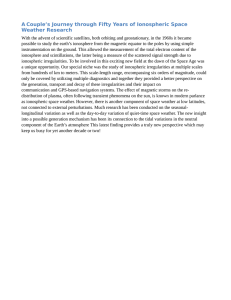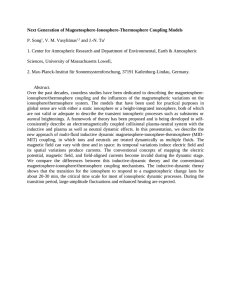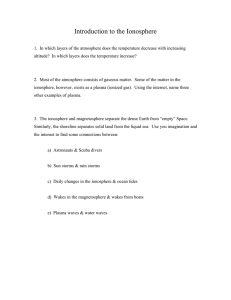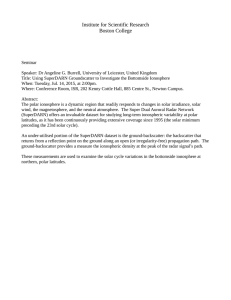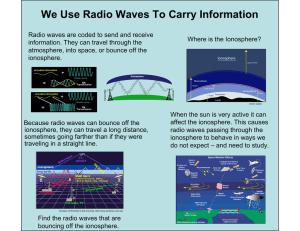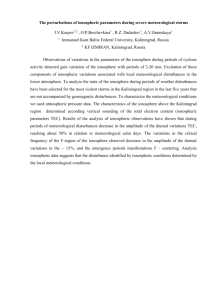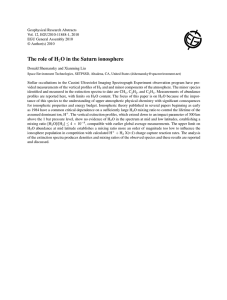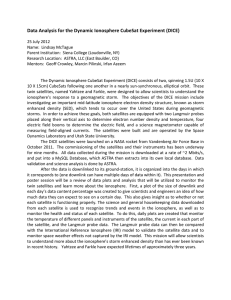CHAPTER 1 INTRODUCTION 1.1
advertisement
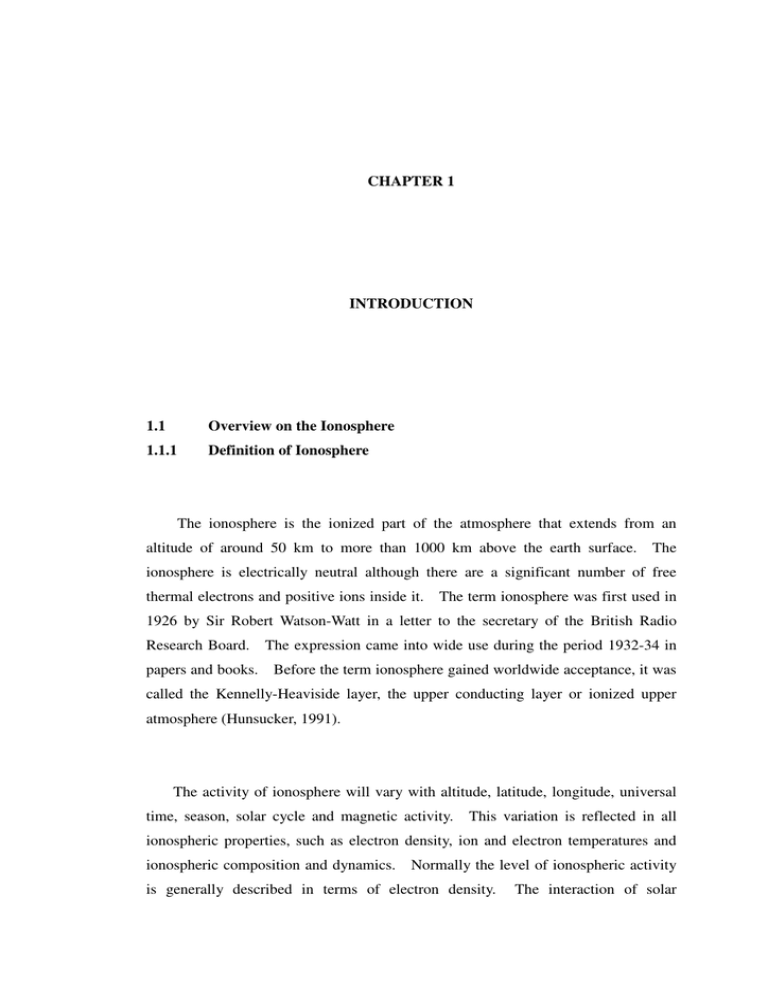
CHAPTER 1 INTRODUCTION 1.1 Overview on the Ionosphere 1.1.1 Definition of Ionosphere The ionosphere is the ionized part of the atmosphere that extends from an altitude of around 50 km to more than 1000 km above the earth surface. The ionosphere is electrically neutral although there are a significant number of free thermal electrons and positive ions inside it. The term ionosphere was first used in 1926 by Sir Robert Watson-Watt in a letter to the secretary of the British Radio Research Board. The expression came into wide use during the period 1932-34 in papers and books. Before the term ionosphere gained worldwide acceptance, it was called the Kennelly-Heaviside layer, the upper conducting layer or ionized upper atmosphere (Hunsucker, 1991). The activity of ionosphere will vary with altitude, latitude, longitude, universal time, season, solar cycle and magnetic activity. This variation is reflected in all ionospheric properties, such as electron density, ion and electron temperatures and ionospheric composition and dynamics. Normally the level of ionospheric activity is generally described in terms of electron density. The interaction of solar 2 radiation (the ultra-violet radiation of the Sun) or charged particles (such as X-rays and cosmic rays) with the Earth’s atmosphere drives the ionospheric behaviour. 1.1.2 Structure of Ionosphere The structure of the ionosphere is very complex due the physical and chemical processes within it. The sun’s extreme ultraviolet (EUV) light, cosmic radiation and X-ray emissions encountering gaseous atoms and molecules in the atmosphere can impart enough energy for photo ionization to occur producing positively charged ions and negatively charged free electrons. Process recombination occurs in the ionosphere when the ions and electrons join again producing neutral atoms and molecules. But in the lower regions of the ionosphere, a process called attachment occurs when the free electrons combine with neutral atoms to produce negatively charged ions. The absorption of EUV light increases as altitude decreases. Due to the absorption and the increasing density of neutral molecules, a layer of maximum electron density is formed. However, since there are many different atoms and molecules in the ionosphere and each of it have different rates of absorption, a series of distinct layers or regions of electron density exist. These are denoted by the letters D, E, F1 and F2, which are usually are collectively referred to as the bottom side of the ionosphere. The part of the ionosphere between the F2 layer and the upper boundary of the ionosphere is termed the topside of the ionosphere. structure of the ionosphere. Figure 1.1 below depicts the 3 Figure 1.1: Structure of Ionosphere (Komjathy, 1997). 1.1.3 Characteristics of Ionosphere Structures According to Komjathy (1997) the D layer extends from about 75 to 90 km above the earth. D-layer ionization is produced by solar UV light, X-rays and cosmic radiation at any time of day or night. Due to this, the electrons may become attached to molecules and atoms forming negative ions that cause the D layer to disappear, at night time. While during the day time, the electrons tend to detach themselves from the ions causing the D layer to reappear, as the consequence of sun’s radiation. Since the electrons in D layer at the altitude of about 60 to 70 km are present by day but not by night, it causes a distinct diurnal variation in the electron density. In Davies (1990), the lower part of D layer was referred to as the C layer where the cosmic radiation is the only source of ionization compared to the middle and 4 upper part of the D layer where both the cosmic radiation and X-ray emissions are present (Komjathy, 1997). According to the National Oceanic and Atmospheric Administration (NOAA), the E layer extends from about 95 to 150 km above the earth. Since the ionization mostly depends on the level of solar activity and the zenith angle of the sun, ionization drops to low values at night. Although the E layer does not completely vanish at night, however, for practical purposes it is often assumed that its electron density drops to zero at night. day time. Due to that, the E layer is said to be only present by In that respect, the primary source of ionization is the sun’s X-ray emissions, causing the electron densities in E layer showing distinct solar-cycle, seasonal and diurnal variations. to be irregular. According to NOAA, the E-layer effects are noted Other subdivisions of the E-layer, after isolating the irregular occurrence within this region into separate layers, are also labelled with an E prefix. These layers are the thick layer, E2, and a highly variable thin layer, Sporadic E. Ions in these regions consist of mainly O2+. The F1 layer is the lower part of the F layer, which extends from about 170 to 250 km above the earth. The main source of ionization in the F1 layer is the EUV light while the electron densities are primarily controlled by the zenith angle of the sun. Because of this, the F1 layer exists only during daylight hours and will disappear at night, so it’s only observed during the day time. changes rapidly in a matter of minutes. electron densities range between 2.3x10 When it is present, it During typical noon time, the mid-latitude 11 and 3.3x1011 electrons/m3 in according to the solar activity (Komjathy, 1997). From about 250 to 500 km above the earth is the region of the F2 layer. This layer is present 24 hours a day but varies in altitude with geographical location, solar activity, and local time. The critical frequency for this layer peaks after local noon time and decreases gradually, thus showing a linear dependency of the F2 layer on the number of solar sunspot. Here, the typical mid-latitude noon time electron 5 densities range between 2.8x1011 and 5.2x1011 electrons/m3 in according to the solar activity. The global spatial distribution of this layer also reveals a strong geomagnetic dependence rather than the solar zenith angle dependence (Komjathy, 1997). The top side of the ionosphere starts at the height of maximum density of the F2 layer of the ionosphere and extends upward with decreasing density to a transitional height where O+ ions become less numerous than H+ and He+. The transition height varies but seldom drops below 500km at night or 800km during daytime, although it may lie as high as 1100km (http://www.ngdc.noaa.gov/stp/IONO/ionostru.html). From above, the existence of the D, E, and F1 layers are noted to be primarily controlled by the solar zenith angle and showing a strong diurnal, seasonal and latitudinal variation. The diurnal variation of the D, E, and F1 layers also implies that they tend to reduce greatly in size or even will vanish at night time. In contrast, the F2 layer is present for 24 hours and is where the maximum electron density usually occurs. This happens as a consequence of the combination of the absorption of the EUV light and increase of neutral atmospheric density as the altitude decreases. Thus, this layer is commonly taken into consideration to represent the whole layer of the ionosphere, during the calculations of the ionospheric delay. 1.1.4 Effects of Ionosphere Delay on Satellite Applications The ionosphere is one of the main sources of error in the vast areas of satellite-related applications. Those satellite applications that will be affected by 6 the ionospheric effect are those which are directly related to satellite signal transmission system, such as navigational satellite operators example U.S. Global Positioning System (GPS), Russian Navigational System (GLONASS) and European Navigational System (Galileo). Other than that, radio and television operations utilising satellite communication; space weather forecasts; space and aero industries and the military are also significantly affected. In the space and aero industries, the ionosphere may affect the spacecraft designs, its internal and surface charging, sensor interference, satellite anomalies, loss of navigational signal phase and amplitude lock, besides affecting the planning of the electromagnetic environment in manned spacecraft’s travels. In the military, the ionospheric effect made its presence felt in terms of space communication and navigation as it causes loss of high frequency (HF) communications and direction finding, causes clutter in the horizon radar; disrupts targeting and extra or very low frequency (ELF/VLF) communications with submarines, besides contributed to reduced detection of missile launch. Furthermore, scientists using remote sensing measurement techniques -in astronomy, biology, geology, geophysics, seismology and many more fields were very much affected where discrepancies in their readings arises and thus compensation of the effects of the ionosphere on their observations are needed. Besides, those applications which does not utilise the satellite system but only involve signal and wave transmissions will be affected as well. For example, phone communication where it causes possible interference; radio communication agencies and amateur radio operators where efficiency of communication is compromised. Irregularities of the effect of the ionospheric delay can range from a few meters to a few kilometres. It will scatter satellite radio signals when it is propagated through the ionosphere. This will lead to rapid phase and amplitude fluctuations and also variations in the angle of arrival and polarization of the radio signals, which are collectively known as ionospheric scintillation. Among the ionospheric scintillation that is important in satellite application are the amplitude scintillation and phase scintillation. 7 Amplitude scintillations, can reach 20 dB at 1. 5 GHz during high solar activity times (Bishop et al., 1996). It induces signal fading and cycle slips. When the signal fading exceeds the fade margin or the threshold limit of a receiving system, message errors in satellite communications are encountered and loss of lock occurs in navigational systems. The amplitude scintillation typically can last for several hours in the evening time, which is broken up with intervals of no fading in between (Klobuchar, 1991). Phase scintillations will cause Doppler shifts and may degrade the performance of phase-lock loops. For example, in GPS navigation systems, the Doppler shifts caused by TEC variations can be up to 1-Hz/second, which may cause some narrow-band receivers to lose lock on the signals. This is due to the rapid frequency changes in the received signals, which are greater than the receiver bandwidth. The phase scintillation also may affect the resolution of space-based synthetic aperture radars. The duration of strong phase scintillation effects are limited from approximately one hour after local sunset to local midnight (Klobuchar, 1991). Although the ionospheric scintillation is unlikely to affect all of the satellite in a receiver's field of view, they will have impact on the accuracy of the result of the navigation solution by degrading the geometry of the available constellation. is the most severe test on a GPS receiver in the natural environment. This Consequently, the coverage of both the satellites and the irregularities as well as the intensity of scintillation activity will all contribute to the accuracy of the result of the final solution (Klobuchar, 1991). 8 1.2 Problem Statement Estimating and mapping the ionospheric delay for the whole country are being performed on a real time basis by many developed countries in the world. The time series of this type of map can be used to derive average monthly maps describing major ionospheric trends as a function of local time, season and spatial location (Weilgosz et al, 2003a). By analyzing these maps, ionospheric forecasting and broadcasting can be done and applied to many related fields or researches. Unfortunately, this capability is currently absent in Malaysia where being in the tropical region, such information are vital for many applications. This research work will explore and develop the basic infrastructure such as ionospheric content computation, suitable interpolation method and finally mapping of the Total Electron Content (TEC) of the Malaysian region. 1.3 Research Objectives The objectives of this research are: 1. To develop an efficient approach in mapping TEC over a regional area using interpolation methods. 2. To define the most suitable interpolation method for mapping the TEC over the Malaysian region. 9 1.4 Research Scope The scope of this research is confined to the following areas: 1. Mapping the TEC over a regional area using an efficient interpolation method. The interpolation methods used here focus only on the inverse distance weighting, multiquadric and sphere multiquadric, as both the inverse distance weighting and multiquadric methods are among the commonly used method. Whereas sphere multiquadric method were included to study a method which interpolates from a spherical plane as opposed to the commonly used flat plane in the two former methods. 2. Producing a regional TEC map and numerical result that can be utilised for many satellite based observation applications. 3. TEC data from the model International Reference Ionosphere 2001 (IRI-2001) -an empirical model of the ionosphere based on all available data sources; please refer to section 4.2 for more details- rather than real observations were used in the interpolation processing step. 4. The research results were analysed using the Root Mean Square (RMS) method. 5. 1.5 The grid size of the output TEC map is 0. 5° x 0. 5°. Significance of Research This research has its significance in terms of establishing the superiority of different interpolation methods in the mapping of the ionospheric effect on the 10 Malaysian region. This research also has its significance in terms of the development of a program to estimate the ionospheric effect for the whole of Malaysia, using the interpolation method which was found to be more suitable in the Malaysian context. The program is an alternative way for the amateur satellite users, especially Global Positioning System (GPS) single frequency users to compute the ionosphere errors in the satellite signals. Besides that, this program helps in terms of cost saving, as it provides an alternative to replace the expensive commercial software, such as Trimble Geomatics Office, Leica SKI-Pro, Waypoint GrafNav, EZSurv and RADAN. 1.6 Study Area The study area for this research was the whole region of Malaysia. The coordinate of the study area ranges from 0°N to 8°N latitude and 99°E to 120°E longitude, which can be seen in Figure 1.2 below: Figure 1.2: Study Area. 11 1.7 Thesis Outline Chapter 1 generally introduces the user to the ionosphere. Besides that, this chapter also discusses the problem statements, research objectives and scope, the significance of research and the area of study. The literature reviews were discussed in Chapter 2. Literature reviews were very important in offering guidelines, guidance and inspirations on the ways on how this research was to be carried out. Chapter 3 explains about the different interpolation techniques that were used in this research. The research methodology is discussed in Chapter 4. This chapter contains the explanation of the data collection and the processing steps of this research. Chapter 5 presents the results of this research. The analysis of the result of this research is also included in this chapter. Lastly, chapter 6 consists of the conclusions of this research. some recommendations were proposed to improve this research. Besides that,
